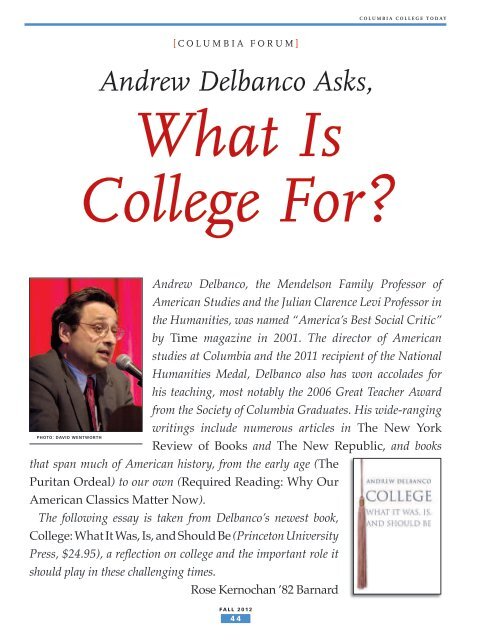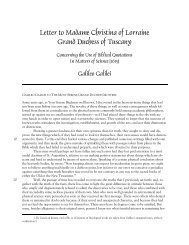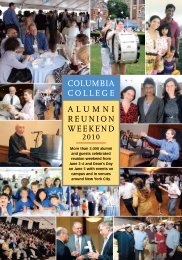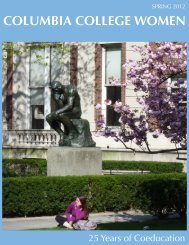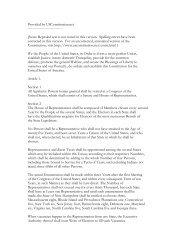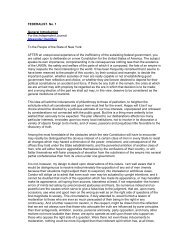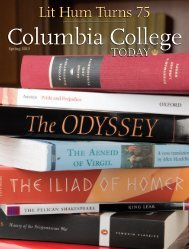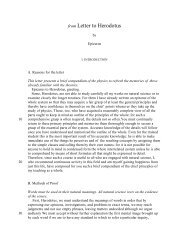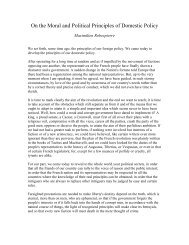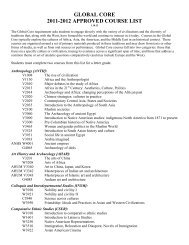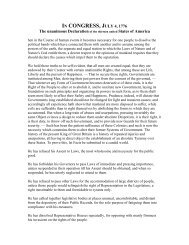Download this issue as a PDF - Columbia College - Columbia ...
Download this issue as a PDF - Columbia College - Columbia ...
Download this issue as a PDF - Columbia College - Columbia ...
You also want an ePaper? Increase the reach of your titles
YUMPU automatically turns print PDFs into web optimized ePapers that Google loves.
COLUMBIA COLLEGE TODAY COLUMBIA COLLEGE TODAY ANDREW DELBANCO ASKS, WHAT IS COLLEGE FOR?<br />
PHOTO: DAVID WENTWORTH<br />
Andrew Delbanco, the Mendelson Family Professor of<br />
American Studies and the Julian Clarence Levi Professor in<br />
the Humanities, w<strong>as</strong> named “America’s Best Social Critic”<br />
by Time magazine in 2001. The director of American<br />
studies at <strong>Columbia</strong> and the 2011 recipient of the National<br />
Humanities Medal, Delbanco also h<strong>as</strong> won accolades for<br />
his teaching, most notably the 2006 Great Teacher Award<br />
from the Society of <strong>Columbia</strong> Graduates. His wide-ranging<br />
writings include numerous articles in The New York<br />
Review of Books and The New Republic, and books<br />
that span much of American history, from the early age (The<br />
Puritan Ordeal) to our own (Required Reading: Why Our<br />
American Cl<strong>as</strong>sics Matter Now).<br />
The following essay is taken from Delbanco’s newest book,<br />
<strong>College</strong>: What It W<strong>as</strong>, Is, and Should Be (Princeton University<br />
Press, $24.95), a reflection on college and the important role it<br />
should play in these challenging times.<br />
[ COLUMBIA FORUM]<br />
Andrew Delbanco Asks,<br />
What Is<br />
<strong>College</strong> For?<br />
Rose Kernochan ’82 Barnard<br />
FALL 2012<br />
44<br />
One of the peculiarities of the teaching<br />
life is that every year the teacher<br />
gets older while the students stay the<br />
same age. Each fall when cl<strong>as</strong>ses resume,<br />
I am reminded of the ancient<br />
Greek story of a kindly old couple<br />
who invite two strangers into their<br />
modest home for a meal. No matter<br />
how much the hosts drink, by some<br />
mysterious trick their goblets remain<br />
full even though no one pours more wine. Eventually, the guests<br />
reveal themselves <strong>as</strong> gods who have performed a little miracle to<br />
express their thanks. So it goes in college: every fall the teacher<br />
h<strong>as</strong> aged by a year, but the cl<strong>as</strong>s is replenished with students who<br />
stay forever young.<br />
For <strong>this</strong> and many other re<strong>as</strong>ons, the relation between teacher<br />
and student is a delicate one, perhaps not <strong>as</strong> fraught <strong>as</strong> that between<br />
parent and child, or between spouses or siblings, but sometimes<br />
<strong>as</strong> decisive. Henry James captured it beautifully in a story<br />
called The Pupil, which is not about a college teacher but about a<br />
private tutor who h<strong>as</strong> come to love the child whom he is trying to<br />
save from his parents:<br />
When he tried to figure to himself the morning twilight<br />
of childhood, so <strong>as</strong> to deal with it safely, he perceived that<br />
it w<strong>as</strong> never fixed, never arrested, that ignorance, at the<br />
instant one touched it, w<strong>as</strong> already flushing faintly into<br />
knowledge, that there w<strong>as</strong> nothing that at a given moment<br />
you could say a clever child didn’t know. It seemed<br />
to him that he both knew too much to imagine [the child’s]<br />
simplicity and too little to disembroil his tangle.<br />
Embedded in <strong>this</strong> p<strong>as</strong>sage is the romantic idea that the student<br />
possesses latent knowledge of ultimate things, and that the<br />
teacher’s t<strong>as</strong>k is to probe for the lever that rele<strong>as</strong>es knowledge<br />
into consciousness.<br />
In trying to make it happen, even — perhaps especially — a<br />
good teacher can sometimes seem brutal. The famously demanding<br />
Joseph Schwab, for example, who taught for years in<br />
the “Biological Sequence” course at the University of Chicago,<br />
w<strong>as</strong> known for “putting one student in the hot seat for a while<br />
… working that person <strong>as</strong> thoroughly and creatively <strong>as</strong> possible<br />
before moving on to another.” One Chicago alumnus, Lee<br />
Shulman, former president of the Carnegie Foundation for the<br />
Advancement of Teaching, recalls that sitting in Schwab’s cl<strong>as</strong>s<br />
“fostered clammy hands, damp foreheads” and, to put it mildly,<br />
“an ever-attentive demeanor.” This figure of the “tough love”<br />
teacher — think of Annie Sullivan in The Miracle Worker or Professor<br />
Kingsfield in The Paper Ch<strong>as</strong>e — h<strong>as</strong> become a cliché of our<br />
culture, and like all clichés, it contains some truth, though doubtless<br />
simplified and unduly generalized. It also seems less and less<br />
pertinent to the present. At most colleges today, a student experiencing<br />
such anxiety would likely drop the cl<strong>as</strong>s for fear of a poor<br />
grade (compulsory courses of the sort that Schwab taught have<br />
become rare), and the teacher would risk a poor score on the endof-semester<br />
evaluations.<br />
Whatever the style or technique, teaching at its best can be a<br />
FALL 2012<br />
45<br />
generative act, one of the ways by which human beings try to<br />
cheat death — by giving witness to the next generation so that<br />
what we have learned in our own lives won’t die with us. Consider<br />
what today we would call the original “mission statement”<br />
of America’s oldest college. The first fund-raising appeal in our<br />
history, it w<strong>as</strong> a frank request by the founders of Harvard for financial<br />
help from fellow Puritans who had stayed home in England<br />
rather than make the journey to New England. Despite their<br />
mercenary purpose, the words are still moving almost four hundred<br />
years after they were written:<br />
After God had carried us safe to New England, and we<br />
had built our houses, provided necessaries for our livelihood,<br />
reared convenient places for God’s worship, and<br />
settled the civil government, one of the next things we<br />
longed for and looked after w<strong>as</strong> to advance learning and<br />
perpetuate it to posterity; dreading to leave an illiterate<br />
ministry to the churches, when our present ministers<br />
shall lie in the dust.<br />
These mixed sentiments of faith and dread have always been<br />
at the heart of the college idea. They are evident at every college<br />
commencement in the eyes of parents who watch, through a<br />
screen of memories of their own receding youth, <strong>as</strong> their children<br />
advance into life. <strong>College</strong> is our American p<strong>as</strong>toral. We<br />
imagine it <strong>as</strong> a verdant world where the harshest sounds are the<br />
reciprocal thump of tennis balls or the clatter of cleats <strong>as</strong> young<br />
bodies trot up and down the fieldhouse steps. Yet bright with<br />
hope <strong>as</strong> it may be, every college is shadowed by the specter of<br />
mortality — a place where, in that uniquely American se<strong>as</strong>on of<br />
“fall and football weather and the new term,” the air is redolent<br />
with the “Octoberish smell of cured leaves.”<br />
But what, exactly, is supposed to happen in <strong>this</strong> bittersweet<br />
place — beyond sunbathing and body-toning and the competitive<br />
exertions, athletic and otherwise, for which these are just the<br />
preliminaries? First of all, it should be said that the p<strong>as</strong>toral image<br />
of college h<strong>as</strong> little to do with what most college students experience<br />
today. A few years ago, Michael S. McPherson, president<br />
of the Spencer Foundation and former president of Macalester<br />
<strong>College</strong>, and Morton O. Schapiro, former president of Williams<br />
Teaching at its best can be a generative act, one of the<br />
ways by which human beings try to cheat death.<br />
<strong>College</strong> (now of Northwestern University), pointed out that “the<br />
nation’s liberal arts college students would almost certainly fit<br />
e<strong>as</strong>ily inside a Big Ten football stadium: fewer than one hundred<br />
thousand students out of more than fourteen million.”<br />
Since then, the number of undergraduates h<strong>as</strong> grown by<br />
nearly a third, to around eighteen million, while the number in<br />
liberal arts colleges — by which McPherson and Schapiro meant<br />
a four-year residential college that is not part of a big university,<br />
and where most students study subjects that are not narrowly vocational<br />
such <strong>as</strong> nursing or computer programming — remains<br />
about the same. Many college students today, of whom a growing<br />
number are older than traditional college age, attend commuter<br />
or online institutions focused mainly on vocational training.<br />
Often, they work and go to school at the same time, and take<br />
more than four years to complete their degree, if they complete it<br />
at all. Five years from now, undergraduate students in the United<br />
States are projected to exceed twenty million, and President


